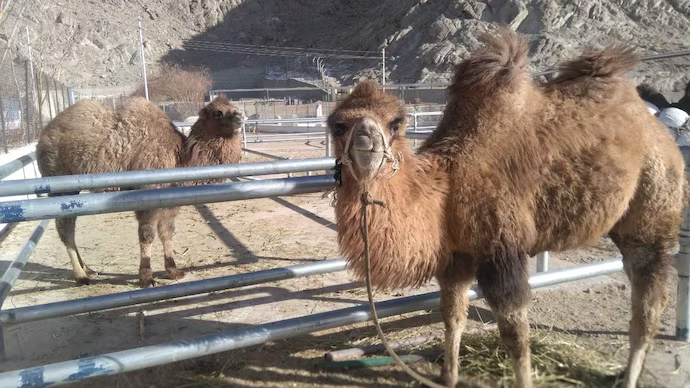Ladakh’s Terrain Challenges: How Bactrian Camels Are Becoming a Formidable Ally for the Indian Army
Chandigarh: The Indian Army (IA) has formally inducted twin-humped Bactrian camels for logistics and patrol duties along the high-altitude, disputed border with China in eastern Ladakh, where all-terrain vehicles and mules find the going difficult.
The Defence Institute of High Altitude Research (DIHAR) – a Defence Research and Development Organisation (DRDO) unit – working in collaboration with the IA’s Remount and Veterinary Corps (RVC), which began trialling these camels in Ladakh in 2023, handed over 14 of them to the Leh-based 14 ‘Fire and Fury’ Corps last month.
Equipped with custom-engineered harnesses and modular load-carrying frames, developed by the Army Design Bureau and DRDO affiliates, these camels will now undertake high altitude transportation and reconnaissance missions with their handlers, along remote and rugged frontier stretches.
Each animal is tasked with carrying between 170–180 kg of supplies
Each animal is tasked with carrying between 170–180 kg of supplies – including food, ammunition, medical kits, surveillance and communication and sundry other materials – over altitudes ranging from 14,000 to 17,000 feet, and executing terrain monitoring duties.
Towering at an imposing 7 feet at the hump and weighing 600-1,000 kg, these hardy beasts possess formidable strength and stamina. Their ability to haul loads across rugged terrain makes them indispensable in Ladakh, where, from October onwards, temperatures start plunging, even reaching minus 25 degrees in the winter.
The Bactrian camels’ bushy eyebrows, long eyelashes, and closable nostrils protect them against dust and icy gusts, while their broad, calloused feet enable steady movement across snow, rock, and sand with ease. They can also go longer without water – up to 72 hours – making them ideal for Ladakh’s arid and freezing desert-like terrain.
These Bactrians participated in comparative trials alongside Rajasthan’s single-humped dromedary camels, bred for blistering sands and scorching plains, conducted by the DIHAR-RVC combine around 2003. Both species were evaluated on their load-bearing capacity, stamina and adaptation to extreme cold in rarefied atmospheres at over 14,000 feet.
The trials also tested the camels for patrolling tasks under simulated small arms and mortar fire in high-altitude zones and the Bactrians outperformed on both counts; hauling weight and remaining unflustered under fire, ultimately earning 14 of them official entry into military service.
Native to the steppes of Central Asia, the Bactrian camel (Camelus bactrianus) – named after the ancient region of Bactria, now part of Afghanistan, Uzbekistan, and Tajikistan – was first domesticated over 4,000 years ago. Adapted to endure some of the planet’s harshest environments, including arid plateaus, icy mountains, and freezing deserts, these double-humped camels were uniquely suited to the Ladakh’s high-altitude stark and freezing terrain.
Used to be central to trade on the ancient Silk Road
Historically, Bactrian camels were central to trade on the ancient Silk Road, ferrying silk, tea, spices, and precious stones across vast distances from China, Tibet and Ladakh to Europe. Their ability to carry heavy loads, withstand sub-zero temperatures, and survive long stretches without food or water, made them invaluable to caravan commerce for centuries.
A small number them gravitated to Ladakh’s Nubra Valley, surviving here for aeons thereafter. But in recent decades their numbers teetered on the brink of extinction, even as they continued to thrive across their original homelands of Mongolia, China’s Xinjiang province, Kazakhstan, Afghanistan, and Iran where they remained essential to livelihoods in remote, rugged areas like the Gobi Desert and the Central Asian steppes.
The advent of mechanisation, loss of traditional trade routes, and dwindling interest among locals in breeding them saw their population in Ladakh falling drastically from a little over a thousand in the early 1900s, to merely around 40 in 1986. River drownings, predation, and scarce grazing in Ladakh’s harsh landscape, too contributed to their dwindling population.
But sustained efforts in recent years by local communities, environmentalists and animal rights groups, aided by government incentives, tourism and recognition of Bactrian camels’ ecological and cultural value, led to their gradual revival.
A state-run breeding and camel conservation farm came up at Chuchot near Leh around 2003–2004 and a rise in camel safari tourism – particularly around Diskit, Nubra’s largest town known for its Buddhist monastery overlooking the Shyok River, and nearby Hunder, provided locals strong economic incentives to breed and care for these animals. Today, the Bactrian camel population in Nubra has rebounded to over 300, restoring the animals iconic status once more in the region.
Deep bonds and shared hardships of Jawans and IA animal units
However, any story on an IA animal unit remains incomplete without the endearing tradition of jawans naming them and caring from them, reflecting deep bonds and shared hardships forged in the most inhospitable environments between man and beast.
Be it mules, horses – and now camels – these military animals have always been more than mere beasts of burden to their Army minders. To many they are simply dear companions, lifelines, and often the only silent presence during lonely high-altitude patrols. In Ladakh’s biting cold, where human contact is scarce, these animals also become a part of the soldiers emotional eco-system.
According to media reports one of the first female Bactrian camels bred and trained by the DIHAR-RVC combine was named Rangoli, born to Chinku and Tinku as part of the formal breeding programme. Her birth was not just a scientific success, but also symbolically significant – a new beginning for a species once on the brink of extinction; her name, meaning rows of colours, too evoked festivity in contrast with the stark and frozen landscape she was born into.
Rangoli’s handlers reportedly marked her arrival with quiet pride, and she quickly became something of a mascot – gentle, hardy, and unflinching during load trials. As one of the first domestically bred Bactrian camels under India’s military initiative, Rangoli stood as a testament to revival, adaptation, and the enduring bond between soldiers and their animal companions.
Robotic load carriers replacing mule trains
As the IA modernises its logistics in high-altitude and rugged terrains, its mule trains that have been in service for over two centuries were also being gradually replaced by robotic load carriers. These four-legged autonomous or semi-autonomous machines, developed by DRDO and private partners, are designed to carry up to 100 kg of supplies across difficult terrain in the Himalayas and the north-eastern jungles, where vehicles cannot operate.
Equipped with sensors, GPS navigation, and terrain-mapping capabilities, these robotic mules can be deployed in extreme cold and thin air, reducing the physical strain on jawans and the dependency on live animals, especially mules.
However, while efficient and tireless, these machines – eponymously and ironically named Multi-Utility Legged Equipment or MULEs-lacked the personality and bond that animals like mules or camels offered. This was especially so in the icy loneliness of Ladakh where no robot – however advanced – can nuzzle, bray, or offer companionship or the warmth of breath on a soldier’s freezing glove.
Also Read: Russia Oil Trade & Trump Tariffs: How India Faces Economic Fallout Amid Rising U.S. Pressure







